Ground improvement using various methods is one of the most important applications of geotechnical science today. The construction of structures on unsuitable substrates and problematic soils creates the requirement to prioritize improvement operations to adapt the substrate before starting the design and execution of the structure. The axes of activity and provision of services of Istasazeh Engineering Construction Co. in the field of soil improvement include various methods, which are presented below:
- Micropile Underpinning or Root Pile Construction
- Stone Column
- Jet Grouting
- Deep Soil Mixing (DSM)
- Dynamic Compaction
- Pile foundation or (Concrete Pile , Steel Pile)
- fill surcharge preloading
- Drainage
- Geosynthetic soil

1) Micropile Underpinning or Root Pile Construction
Piles with a diameter of less than 30 cm, which are accompanied by steel reinforcement and grouting, are referred to as micropiles. The micropile method usually involves drilling a borehole, placing the reinforcement and then injecting it. Micropiles can withstand significant axial forces and to some extent lateral forces and can be used as a replacement for conventional driven piles or pre-drilled columns or as part of a pile and soil system, depending on the design idea. It is possible to execute micropiles in projects that have limited access and in any type of soil and ground conditions.


2) Vibro Stone Column
Execution of vibro stone column to improve or strengthen the soil involves moving part of the upper layers of problematic soils with a dense vertical stone column that should be well penetrated in the weak layers around the stone column. When water pressure is used in the stone column process to improve or consolidate the soil, this method is called Vibro Replacement or wet process of the stone column. But when the execution of wet process of stone columns in semi-saturated soils such as old rock mass is the process of Ground improvement without water pressure and is called the execution of stone columns by dry or vibro replacement method. The vibro replacement stone column method consists of three phases of drilling, compaction and reinforcement and execution of sand cushion.

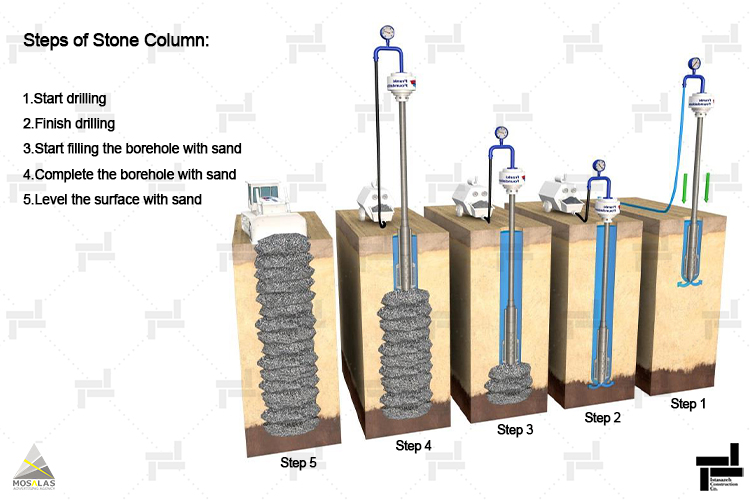
3) Jet Grouting
Today, in order to achieve the necessary geotechnical conditions for Ground improvement or land improvement, dewatering and stabilization, etc., Jet grouting methods are used in soil or rock. Jet grouting is generally divided into two types of Jet grouting in rock and Jet grouting in soil. Jet grouting method is one of the most effective methods of soil improvement. Jet grouting is a method of soil improvement in which the slurry is injected into the soil through very high pressure and high speed through nozzles and causes destruction, change, modification and improvement of soil structure. During this process, the soil particles are mixed with the slurry in situ and a homogeneous mass of modified soil is formed, which is called the soil-cement column. Soil-cement columns created by Jet grouting into the soil have high strength, low ductility and low permeability and strengthen the soil properties.
Jet grouting is a very reliable and efficient technique for modifying the strength, consolidating or dewatering the soil in place.


4) Deep Soil Mixing (DSM)
Deep Soil Mixing (DSM) is one of the practical methods of ground improvement in the world, which produces soil cement columns and modification of soil characteristics by injecting stabilizing materials such as cement or lime using a mechanically hollow shaft drill in the soil. In deep soil Mixing method, the soil characteristics are improved by mixing the soil with cement materials by deep mixers and creating cement soil columns. In addition, by overlapping the columns before full trapping, continuous walls can be constructed under the ground.


5) Dynamic compaction
One of the ground improvement methods is dynamic compaction method. dynamic compaction method involves applying repetitive high-energy blows to the soil surface using percussions weighing 5 to 40 tons from a height of 10 to 30 m. The dynamic soil compaction is one of the methods of deep soil compaction.


The benefits of Dynamic compaction include:
- Increasing soil bearing
- Reducing unwanted subsidence
- Stability of gables
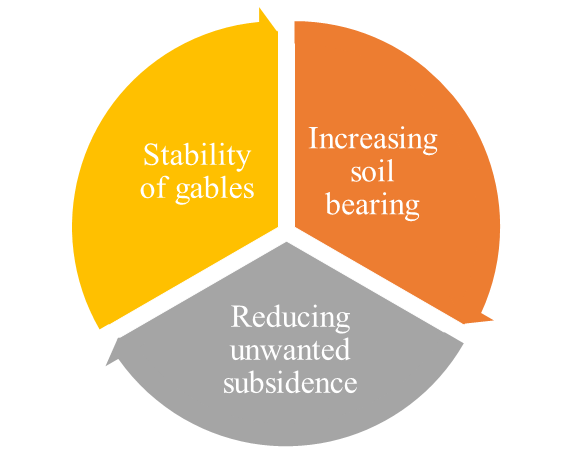
6) Pile foundation or (Concrete Pile , Steel Pile)
Depending on the underground conditions, the groundwater level and the type of cargo to be transported, different types of piles are used in construction work.


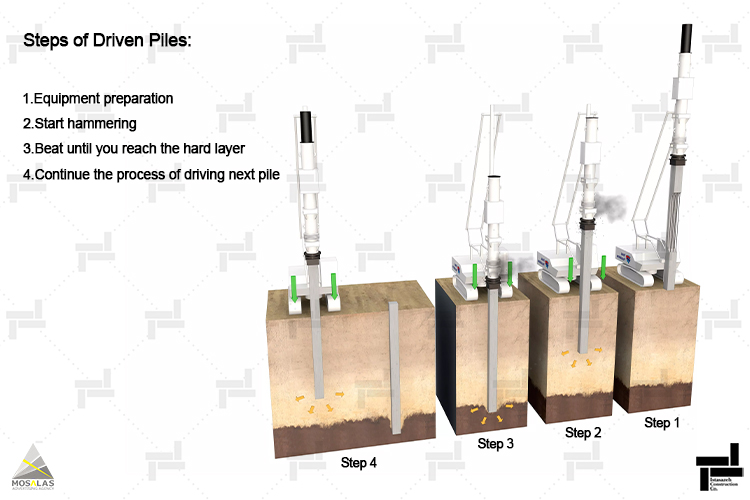
Piles have the following types depending on the materials from which they are made:
A) Steel piles
B) Concrete piles
C) Wooden piles
D) Composite piles

7) Preloading (fill surcharge preloading method)
Preloading is usually referred to as the process of compaction of soil under vertical pressure, which is applied before the final structure is constructed and placed.
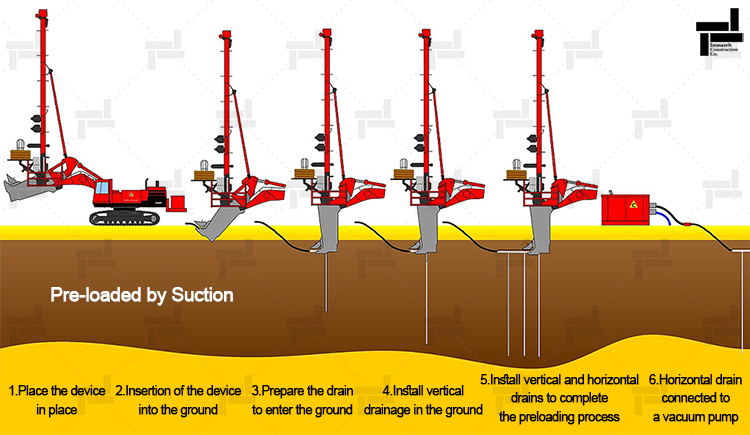
Types of preloading include the following:
- Preloading by embankment
The simplest method for preloading is by embankment, which is done by pouring the embankment on loose soil.
2) Preloading by vacuum or suction
In cases where the provision of soil for the construction of the embankment is not possible or is subject to a very high cost, and also in places where the substrate soil is so soft that the placement of the embankment causes stability problems, the use of vacuum method in these cases is appropriate and practical. In the consolidation method, it is replaced by the overhead vacuum or load required for consolidation at atmospheric pressure.

8) Drainage
One of the major problems we face when excavating construction projects or draining construction excavations is the entry of water into the excavation area.
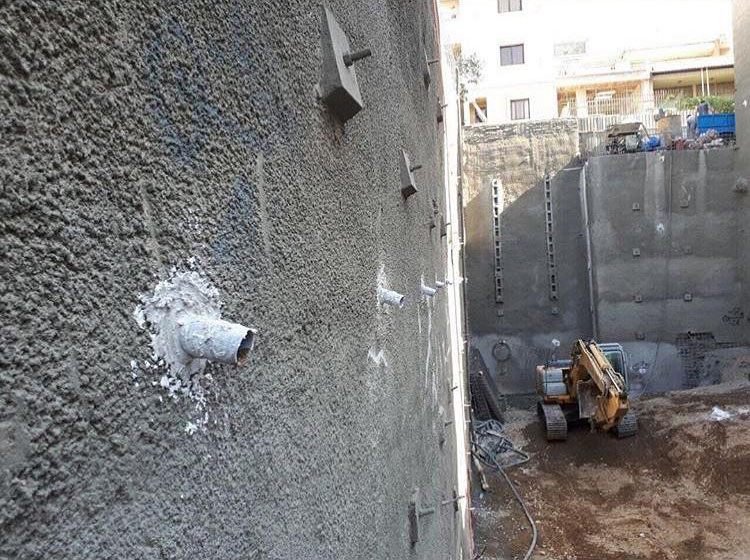
may be one or more of the following are water entering reasons to the excavated area:
- Underground currents
- Aqueducts
- Sewage leakage from sewage disposal systems of neighboring buildings
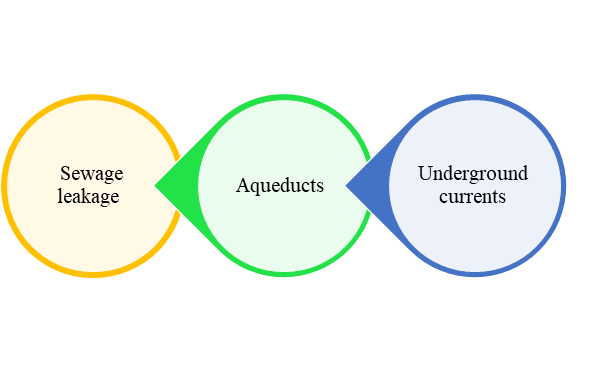
Building drainage can be considered as the most effective way to control such events for construction projects. Usually, the drainage system of construction excavations is used along with the use of geomembrane insulation or concrete dewatering to protect the structures against underground events and to prevent any moisture from entering the structures.
9) Geosynthetic soil
Geosynthetic soil is a set of embankments (usually granules) in which the reinforcing elements in the soil are in the form of belts and nails. Geosynthetic soil is generally resistant to pressure and shear, but weak to tension. In geosynthetic soil, the presence of reinforcing elements in the direction of tensile strain improves soil behavior (similar to reinforced concrete). Geosynthetic soil walls are in the group of flexible walls.






